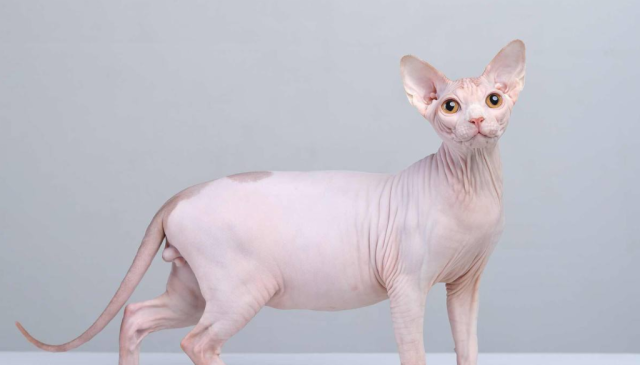Sphynx
IUCN
LCBasic Information
Feature
The fur feels soft and silky, like satin, which is unique among many breeds.
Distribution and Habitat
Originated from Canada
Appearance
Well-developed muscles, deep chest, hunched back, compact abdomen without retraction. Slender limbs, slender bones, hind limbs longer than front limbs. Angular head, wide and wedge-shaped, prominent cheekbones, thin cheeks, regular triangular face, large, upright auricles, towering above the head, pointed and rounded at the end, slightly tilted forward; large, slightly protruding lemon-shaped eyes, slightly tilted, mostly blue and golden; upper corners of the eyes slanted toward the ears, with wide spacing. The tail is as thin and long as a mouse, curved and upturned like a whip.
The hair is sparse, with some thin and soft fetal hair on the ears, mouth, nose, front of the tail, feet and other parts, and the rest of the body is hairless, the skin wrinkles like antelope skin, elastic, the younger the cat, the rounder the face, the more wrinkles on the skin; newborn kittens have many wrinkles and are covered with soft fetal hair. As they age, the fluff only remains on the head, limbs,
Details
The Canadian Sphynx was bred by cat lovers in Toronto, Ontario, Canada in 1966 from a litter of almost hairless kittens through inbreeding and selection, specifically for cat lovers who are allergic to cat hair.

The earliest recorded hairless cats were a pair of brothers named Nellie and Dick who were born in the same litter. In 1903, Sinnick, a New Mexico native, bought them from Native American Indians in Pueblo. In 1966, hairless cats were found again in Toronto, Canada, and the name of the Canadian hairless cat came from this. Shortly thereafter, hairless cats were also found in Minnesota, USA. As the reputation of hairless cats grew, there were reports of hairless cats being found all over the world. As a result, some cat lovers bred Sphynx cats, which were not susceptible to genetic diseases and were not disabled by inbreeding. The breed became successful in cat shows and people began to pay attention to it and became interested in it. TlCA recognized the breed and the cat was recognized as a rare breed in 2005.
In 2010, the Canadian Sphynx was very popular in the UK, but its price was as high as 3,000 pounds. However, people's views on this cat with a very unique appearance are often diametrically opposed. Hairless cat lovers believe that it is the rarest cat breed and a rare treasure, while those who cannot accept its peculiar appearance directly call it a "monster". As of 2008, there were 25 registered hairless cat breeders in the UK who met the standards set by the British Cat Fanciers Management Committee.
Canadian Sphynx cats are gentle, independent, non-aggressive, can get along with other cats and dogs, and are suitable for family breeding.
Protect wild animals and eliminate game.
Maintaining ecological balance is everyone's responsibility!








